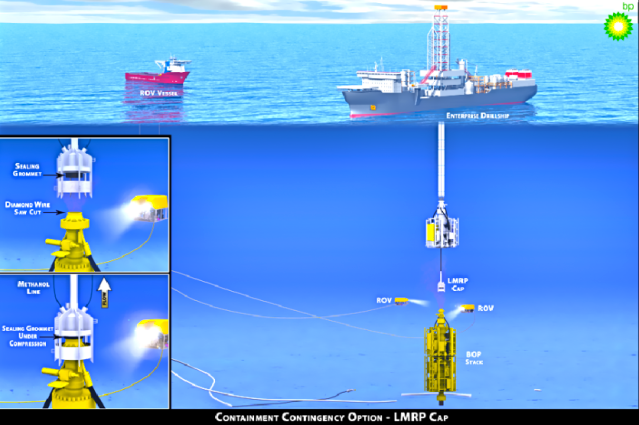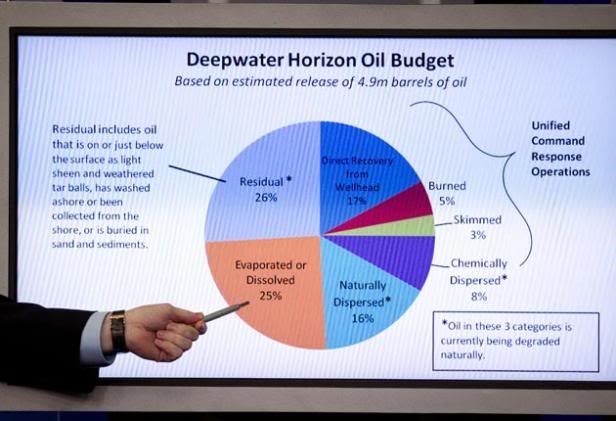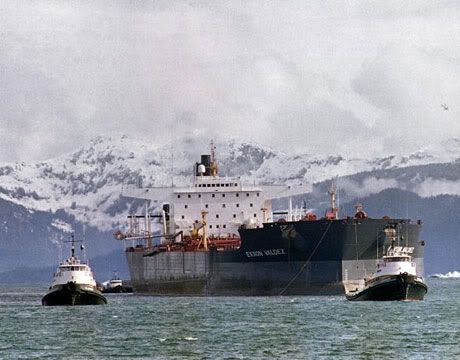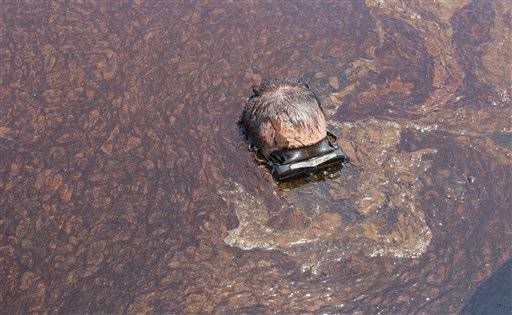Turned on the tube, there’s a live press conference with Rr. Admiral Landry and BP’s Spokesperson Doug Suttles.
Top Kill is officially Not Working.
Suttles
“We’ve tried and it scares everybody that we haven’t succeeded in getting this stopped.”
No. Kidding.
Admiral Landry.
Obviously we’re very disappointed in today’s announcement.
We will continue with a very aggressive response posture (to get this under control)
Have directed BP to to move forward with the next option, LMRP.
(added later quote) The real solution has been and continues to be the relief well.
Mmm, hmm. Yes.
They think that if they can get a good seal over the top, the LMRP Cap, lower marine riser package Cap, might work, which is the option they are going for next.
This is a newly engineered object, different than what they have used before, which is going to go on top on what they have, with a sort of seal, not a mechanical seal, but a “sealing device” and methanol injection for antifreeze, that Suttles says “should” capture a lot of the oil. Will not be a tight fitting may not completely seal off like a flange.
Pipe will be cut with a large crimping device and a big saw to get it ready for its new LMRP CAP. (this is not being done for the pathetic little “top hat” device they lowered to the marine floor, never to be seen again. this is a new thing.)
Wilberforce correctly anticipated this this morning. Where I disagreed is that this was happening this am, is that it is going to take at least 4 days to set up, per the Coast Guard and Suttles, right now. Landry is saying now, more like 4 to 7 days, because people remember the smaller number, and they hit glitches in trying to execute this, she emphasizes this is cutting edge technology. They are using the data they gather from the “sippy tube” other end of the broken pipe to help design this. That is currently what is being shown on the live feed and what was being shown earlier today. I’ve seen then playing around with cutting on this end before.
I thought they would be too timid and/or cautious to try actually cutting the mess on the top of the BOP, because this will release a huge amount of oil that is currently restricted, which they then must be able to get this new cap securely attached, unfrozen inside, to capture, but they are going for it. This is letting more of the Genie out of the bottle, and he’s not going to go back in easier.
My intrepretation is that they fear the well casing is not in very good shape and they want to start siphoning asap in case the relief well fails or the vital structures of the well fails, which Adm. Landry said was a possibility earlier this week. A major hole blow out is only good for the movies. In really, that is a catastrophe which will be unstoppable until all the oil and gas have leached out, which could take….. years.
Suttles is also still bullsh*tting people on the Corexit, says the monitoring shows no toxicity. Says breaking the oil up into tiny droplets will allow the microbes to eat it more easily.
More like it’s keeping under the surface and swirling around in the Gulf in vast swarms.
Suttles: 12,000 feet deep in the relief well, counting 5000 feet of water, best forecast for the relief well is early August.
This is still a very dangerous and risky operation, and if you are in the habit of praying, start doing it.
______
edit update, here’s a picture from Beyond Pathetic of what I shall be calling Oil Hat Sucker #3

We had the containment “outhouse” box that froze shut, the sippy tube stuck up its bum, the drill mud top kill that didn’t, the junk shot that wouldn’t clog the petrotoilet, and the the forlorn little cap that they sunk down there and never used. And now,
Introducing BP’s Oil Spill LMRP Lower Marine Riser Package CAP, aka Oil Hat Sucker #3.
Which is going to use a pressure gasket with no hardware casing, as a fitting on a 12,000 pounds per square inch oil and methane gas wildcat well 5,000 feet under the surface of the Gulf of Mexico.
As the spoof twitter bpTerry of spoof twitter bpPublic Relations said yesterday, “I just bought a magic wand, and I’m going to start waving it. ”
__
second update.
fixed spelling in blockquote, added sentence by Landry which clarifies the relief well is the way they expect to finally get this under permanent control. Suttles reiterated that the other oil gathering devices, the caps, are to test and implement and prevent as much oil as possible from getting loose in the Gulf and washing ashore, while this solution is worked on.
BP’s Tony Hayward is quoted by CNN as being “disappointed” top kill failed. Yeah, we are too. Especially since it was more of a test round and you never did cap off the sippy tube open end.
The CNN guy is so excited he just said the Top Tail Method did not work to kill the well. You could see him wondering if he should correct himself, he just went on.






